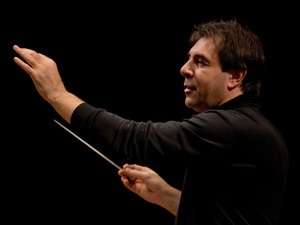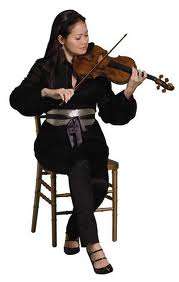|
Back
The World According to Gustav Mahler New York
Isaac Stern Auditorium, Carnegie Hall
04/04/2013 - & March 28, 29, 30, 2013 (Boston)
Gustav Mahler: Symphony No. 3 in D minor
Anne Sofie von Otter (Mezzo-Soprano)
Women of the Tanglewood Festival Chorus, John Oliver (Conductor), Boys of the PALS Children’s Chorus, Andy Icochea Icochea (Conductor), Thomas Rolfs (Posthorn), Elita Kang (Violin), Boston Symphony Orchestra, Daniele Gatti (Conductor)

D. Gatti (© www.danielegatti.com)
At the end of the Boston Symphony Orchestra performance of Mahler’s mighty Third Symphony, I felt a particular sadness. Specifically, a sadness that they wouldn’t be repeating this performance the next day here in Carnegie Hall. For I would have canceled my appointment tonight to hear the New York Philharmonic in the Met Museum–hell, I would have canceled going to my grandmother’s funeral if she were having one–to hear Daniele Gatti’s monumental performance one last time.
Unlike any other Mahler symphony, the composer gives a road map telling exactly what he wants in this piece. It needs no annotators to go into deep descriptions, when the composer explains, “This is what the meadow flowers tell me...This is what the animals in the forest tell me...What humanity tells me...what the angels tell me.”
And this is how he wrote it. Those angels? Obviously a children’s choir with a women’s choir. Those flowers? A graceful minuet. “What love tells me” is a long long string section, like the slow movement of the Fifth, but instead of a harp, the full orchestra coming in at the right moments.
So a skeptic would say that Daniele Gatti had his work cut out for him. Except that Maestro Gatti, perhaps the most dynamic and sensitive Italian conductor since Abbado, gave a performance that was riveting from the first horn fanfare to the final fortissimo chord for the entire orchestra.
Yet it was this opening movement which was more stunning than the complex second part of the Third. Mr. Gatti did not play a “Late Romantic” symphony. He played a piece that was aggressive, intense, literally suspenseful as we waited for the brass choir or tympani to hit their messages. And while this was one of the most felicitous of all Mahler symphonies, the marches were almost frightening under Mr. Gatti’s baton.
Usually, one feels that Mahler’s description of “summer marching in” as a kind of irony, almost a parody march. But no, Mr. Gatti turned his orchestra into a war machine, albeit with those avian tweets from the upper winds. Those double basses all turned their instruments into pianissimo ghosts, the three trombone solos were burnished. At times, it sounded like the Heldenleben march, at times I felt that he should have alleviated the combative music, like Ives did, by sticking in a folk tune, a hymn. But no, Mr. Gatti saw the summer sun as a searing sun, nature’s burning rays as killers as much as creators.
It was a fascinating opening, and so tense, so picturesque that the following minuet carried with it the strains of that movement, as if this was a footnote to his more important message. But Mr Gatti regained that wonderful pace in the third movement, with the eight French horns playing together, and the crisp solo sounds of the snare drum.
The performance was a searing one, thanks to those players of the Boston Symphony Orchestra, which apparently went all out for Mr. Gatti. I hesitate in saying this was an operatic performance, but yes, the orchestra played with the color, the emotion and indeed in the top soprano registers, like a post-Wagnerian apotheosis which needed no human vocal cords whatsoever.
(One thinks of Rossini’s quip that “Opera would be so much better if we didn’t have to use singers.”)

E. Kang (© Courtesy of the Artist)
A word about the soloists, especially Acting Concertmaster Elita Kang. Mahler gave the solo violin lengthy passages in almost all the movements, and Ms. Kang soared with each. The flugelhorn (not Mahler’s posthorn) was played behind the stage doors by Thomas Rolfs of the trumpet department, with a delicacy, a perfection, the sounds coming in and out with different volumes. (Was he playing from different distances?) all the way up to that top note.
As for that unassailable brass section of the BSO, I was wrenched into my seat each time they came in. Except for space limitations here, I would love to list every member of this great consort, its trombone and horn calls, its beautiful cool ensemble playing for those rare times they melded with the strings in the final movement.

A. S. von Otter (© www.annesofievonotter.com)
Vocally, obviously Ms. von Otter is one of the great mezzos of our day. But this was not simply a vocal piece from Zarathustra. She didn’t actually sing it, she virtually chanted it, as a benison, as an orison. “All joy seeks eternity,” she sung, and the words were almost whispered. In my score, Mahler changes the dynamics throughout, but Ms. von Otter (or perhaps Maestro Gatti) decided that the emotion was too deep in Mahler’s thought for those vocal alterations.
The two choruses were clear, bright, angelic (as they should be), and the German uttered with a transparent ebullience.
To repeat, hearing this a second (or third) time would be a joyous experience. And yet...and yet, dozens of people left Carnegie hall during pauses between the movements. They didn’t seem particularly angry or mystified. Simply that they’d had enough.
Perhaps they are to be pitied rather than scorned. Or perhaps, unlike the full house last night, they had left their ears or consciousness or minds at home. For the rest of us, I thank whatever Gods of Nature we possess that we humans could create–and treasure–such floods of color and emotion and unalloyed unfettered rejoicing.
Harry Rolnick
|